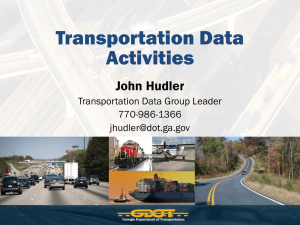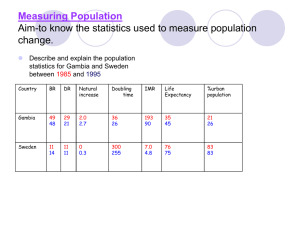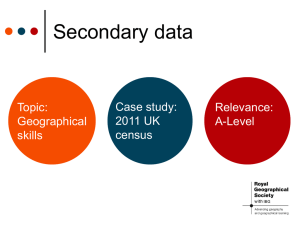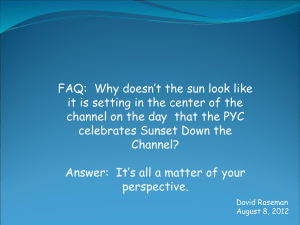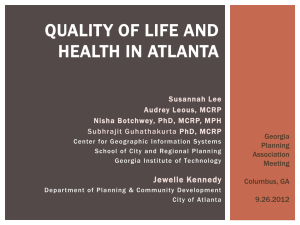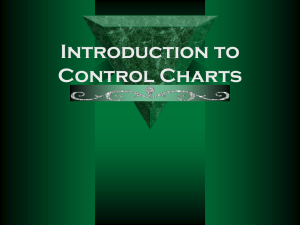Jane Smith – GDOT Transportation Data Activities
advertisement
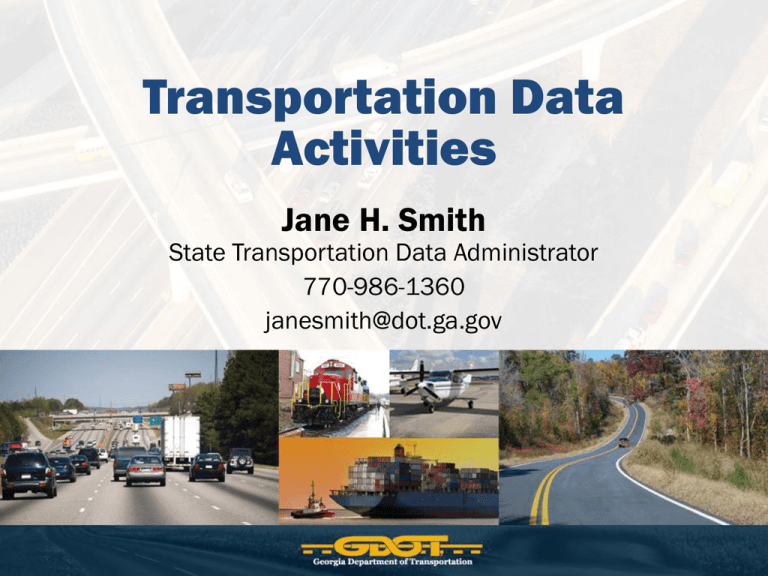
Transportation Data Activities Jane H. Smith State Transportation Data Administrator 770-986-1360 janesmith@dot.ga.gov Local Centerline Mileage • In January 2011, GDOT Commissioner Vance Smith sent a letter to all of Georgia’s Elected Officials – 159 Counties – 531 Municipalities • We requested the they report the total local public road centerline mileage (Paved or Unpaved) • This information is needed to comply with State and Federal Law • LMIG funds will be distributed to Local Governments based on paved and unpaved centerline miles and population • TIA also requires an accurate accounting of centerline miles to calculate funding for each Regional Commission • As of May 3rd, we received reports from – 152 Counties (96%) – 325 Cities (61%) • We provide the mileage to Local Grants Office – If local government reported, we provided that mileage – If local government did not report, we provided our recoded mileage • Confirm that your local government has reported its Center Line Mileage to GDOT on the official Reporting Form • As a Local Government, you are required within 90 days to inform GDOT when you have: – Acquired / Accepted / Abandoned a road – State Code 32-4-41 and 32-4-91 Contact: Doug Alexander Local Government Liaison / Data Manager Office of Transportation Data 770-986-1436 dalexander@dot.ga.gov Statewide Centerline Project • Develop a complete statewide public road centerline • Keep the centerline Up-To-Date • Ensure accurate Local Government mileage • Ensure efficient statewide road inventory • Build relationships with Local Agencies • Help foster a cooperative environment • Roads Extending Beyond or Stopping Short of County Boundary • Topological Errors (Overlapping & Intersecting Road Segments, Dangles) • Conflation Process Errors • Out-of-Date Centerlines • Bad Centerline Geometry • Inaccurate Attribution • Erroneously Coded Roads • Unresolved “Public” and “Unknown” Roads The Centennial Olympic Park Vicinity The Centennial Olympic Park Vicinity As of July 15, 2011 • 4 Complete • 31 In Progress Provide Digital (GIS) Street and Boundary Data Share Street Attribute Data Identify Road Ownership Resolve Boundary Road Issues Be Available To OTD For Consultations Via Phone, E-Mail or Meetings Work With OTD and Neighboring Agencies To Resolve Conflicts Contact: Michael D. Morris Local Government Coordinator Office of Transportation Data 770-986-1366 mimorris@dot.ga.gov Begin Summer 2012 After each decennial census, the Census Bureau identifies and classifies urban and rural areas. The Census Bureau identifies urban and rural areas solely for the purpose of tabulating and presenting statistical data. 1906 - Urban areas of at least 2,500 people 1950 - Urbanized areas of 50,000 or more people 2000 Urban places of at least 2,500 people were identified outside urbanized areas. Urban clusters of 2,500 - 49,999 were defined 17 Atlanta 1990 Census Atlanta 1990 Census Atlanta 2000 Census • FHWA "adjusted" or "smoothed" Urbanized Areas and Small Urban Areas that are used for transportation planning purposes • Expands Census boundary to define boundaries to better reflect local conditions. Atlanta 1990 Census Atlanta 2000 Census Atlanta 2000 Federal-Aid Percentage Guidelines For Federal Functional Classifications Highway Functional Classification Percent of Total Rural Miles Urban Miles Arterials 6 - 12 15 - 25 Collectors 20 - 25 5 - 10 Local roads 65 - 75 65 - 80 Phase I: Preliminary phase (Current – 6/30/12) Phase II: Product Development (6/12 – 12/12) Phase III: Local Government/FHWA Coordination (1/13 - 6/13) Phase IV: Result Reporting (7/13 – 10/13) Contact: Clayton Carter Federal Highway Coordinator Office of Transportation Data 770-986-1366 clayton.carter@dot.ga.gov
